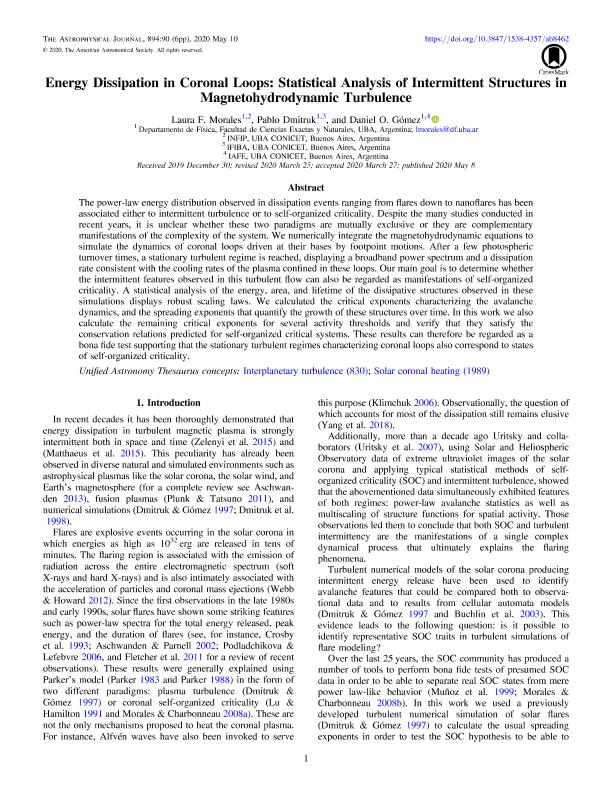Mostrar el registro sencillo del ítem
dc.contributor.author
Morales, Laura Fernanda

dc.contributor.author
Dmitruk, Pablo Ariel

dc.contributor.author
Gomez, Daniel Osvaldo

dc.date.available
2021-11-05T10:56:33Z
dc.date.issued
2020-05
dc.identifier.citation
Morales, Laura Fernanda; Dmitruk, Pablo Ariel; Gomez, Daniel Osvaldo; Energy Dissipation in Coronal Loops: Statistical Analysis of Intermittent Structures in Magnetohydrodynamic Turbulence; IOP Publishing; Astrophysical Journal; 894; 2; 5-2020; 1-6
dc.identifier.issn
0004-637X
dc.identifier.uri
http://hdl.handle.net/11336/146077
dc.description.abstract
The power-law energy distribution observed in dissipation events ranging from flares down to nanoflares has been associated either to intermittent turbulence or to self-organized criticality. Despite the many studies conducted in recent years, it is unclear whether these two paradigms are mutually exclusive or they are complementary manifestations of the complexity of the system. We numerically integrate the magnetohydrodynamic equations to simulate the dynamics of coronal loops driven at their bases by footpoint motions. After a few photospheric turnover times, a stationary turbulent regime is reached, displaying a broadband power spectrum and a dissipation rate consistent with the cooling rates of the plasma confined in these loops. Our main goal is to determine whether the intermittent features observed in this turbulent flow can also be regarded as manifestations of self-organized criticality. A statistical analysis of the energy, area, and lifetime of the dissipative structures observed in these simulations displays robust scaling laws. We calculated the critical exponents characterizing the avalanche dynamics, and the spreading exponents that quantify the growth of these structures over time. In this work we also calculate the remaining critical exponents for several activity thresholds and verify that they satisfy the conservation relations predicted for self-organized critical systems. These results can therefore be regarded as a bona fide test supporting that the stationary turbulent regimes characterizing coronal loops also correspond to states of self-organized criticality.
dc.format
application/pdf
dc.language.iso
eng
dc.publisher
IOP Publishing

dc.rights
info:eu-repo/semantics/openAccess
dc.rights.uri
https://creativecommons.org/licenses/by-nc-sa/2.5/ar/
dc.subject
coronal loops
dc.subject
nanoflares
dc.subject
magnetohydrodynamics
dc.subject
criticality
dc.subject.classification
Astronomía

dc.subject.classification
Ciencias Físicas

dc.subject.classification
CIENCIAS NATURALES Y EXACTAS

dc.title
Energy Dissipation in Coronal Loops: Statistical Analysis of Intermittent Structures in Magnetohydrodynamic Turbulence
dc.type
info:eu-repo/semantics/article
dc.type
info:ar-repo/semantics/artículo
dc.type
info:eu-repo/semantics/publishedVersion
dc.date.updated
2021-09-07T18:27:45Z
dc.journal.volume
894
dc.journal.number
2
dc.journal.pagination
1-6
dc.journal.pais
Reino Unido

dc.journal.ciudad
Londres
dc.description.fil
Fil: Morales, Laura Fernanda. Consejo Nacional de Investigaciones Científicas y Técnicas. Oficina de Coordinación Administrativa Ciudad Universitaria. Instituto de Física del Plasma. Universidad de Buenos Aires. Facultad de Ciencias Exactas y Naturales. Instituto de Física del Plasma; Argentina
dc.description.fil
Fil: Dmitruk, Pablo Ariel. Consejo Nacional de Investigaciones Científicas y Técnicas. Oficina de Coordinación Administrativa Ciudad Universitaria. Instituto de Física de Buenos Aires. Universidad de Buenos Aires. Facultad de Ciencias Exactas y Naturales. Instituto de Física de Buenos Aires; Argentina
dc.description.fil
Fil: Gomez, Daniel Osvaldo. Consejo Nacional de Investigaciones Científicas y Técnicas. Oficina de Coordinación Administrativa Ciudad Universitaria. Instituto de Astronomía y Física del Espacio(i); Argentina
dc.journal.title
Astrophysical Journal

dc.relation.alternativeid
info:eu-repo/semantics/altIdentifier/url/https://iopscience.iop.org/article/10.3847/1538-4357/ab8462
dc.relation.alternativeid
info:eu-repo/semantics/altIdentifier/doi/http://dx.doi.org/10.3847/1538-4357/ab8462
Archivos asociados
